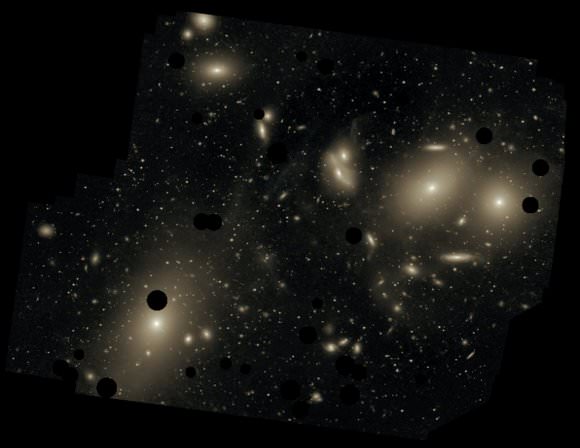Astronomers have peered deep inside the Virgo cluster, and measured the size of one of its most famous members — Messier 87 — with surprising results.
The giant elliptical galaxy isn’t quite as giant as previously believed.
This deep image of the Virgo Cluster, obtained by Chris Mihos of Case Western Reserve University and his colleagues using the university’s Burrell Schmidt telescope, shows the diffuse light between the galaxies belonging to the cluster. North is up, east to the left. The dark spots indicate where bright foreground stars were removed from the image.
At a distance of approximately 50 million light-years, the Virgo Cluster is the nearest galaxy cluster. It is located in the constellation of Virgo (the Virgin) and is a relatively young and sparse cluster. The cluster contains many hundreds of galaxies, including giant and massive elliptical galaxies, as well as more homely spirals like our own Milky Way.
Using ESO’s Very Large Telescope, astronomers have succeeded in measuring the size of giant galaxy Messier 87 and were surprised to find that its outer parts have been stripped away by still unknown effects. The galaxy also appears to be on a collision course with another giant galaxy in this very dynamic cluster.
The new observations reveal that Messier 87’s halo of stars has been cut short, with a diameter of about a million light-years, significantly smaller than expected, despite being about three times the extent of the halo surrounding our Milky Way. Beyond this zone only few intergalactic stars are seen.
This research is presented in a paper to appear in Astronomy and Astrophysics: “The Edge of the M87 Halo and the Kinematics of the Diffuse Light in the Virgo Cluster Core,” led by Michelle Doherty at the Max-Planck-Institute for Extraterrestrial Physics in Garching, Germany.
“This is an unexpected result,” said study co-author Ortwin Gerhard. “Numerical models predict that the halo around Messier 87 should be several times larger than our observations have revealed. Clearly, something must have cut the halo off early on.”
The team used FLAMES, the super-efficient spectrograph at ESO’s Very Large Telescope at the Paranal Observatory in Chile, to make ultra-precise measurements of a host of planetary nebulae in the outskirts of Messier 87 and in the intergalactic space within the Virgo Cluster of galaxies, to which Messier 87 belongs. FLAMES can simultaneously take spectra many sources, spread over an area of the sky about the size of the Moon.
The observed light from a planetary nebula in the Virgo Cluster is as faint as that from a 30-Watt light bulb at a distance of about 6 million kilometres (about 15 times the Earth–Moon distance). Furthermore, planetary nebulae are thinly spread through the cluster, so even FLAMES’s wide field of view could only capture a few tens of nebulae at a time.
“It is a little bit like looking for a needle in a haystack, but in the dark,” said team member Magda Arnaboldi. “The FLAMES spectrograph on the VLT was the best instrument for the job.”
The astronomers have proposed several explanations for the discovered “cut-off” of Messier 87’s, such as collapse of dark matter nearby in the galaxy cluster. It might also be that another galaxy in the cluster, Messier 84, came much closer to Messier 87 in the past and dramatically perturbed it about a billion years ago. “At this stage, we can’t confirm any of these scenarios,” said Arnaboldi. “We will need observations of many more planetary nebulae around Messier 87.”
One thing the astronomers are sure about, however, is that Messier 87 and its neighbor Messier 86 are falling towards each other. “We may be observing them in the phase just before the first close pass,” said Gerhard. “The Virgo Cluster is still a very dynamic place and many things will continue to shape its galaxies over the next billion years.”


An earlier paper on this subject (and referenced in this current paper) entitled ‘Diffuse Light in the Virgo Cluster’ by Chris Mihos can be found here: http://arxiv.org/abs/astro-ph/0508217 . Indeed, the illustration above was obtained by Mihos for his paper. Other recent work has also focused on the motions of planetary nebulae in the halo of M 87, in an attempt to try to find the galaxies to which they belonged (if they were not swallowed up by M 87). Obviously the Virgo Cluster is ‘a very dynamic place’ and we are lucky enough to have ring side seats to the action.
I find it quite interesting that Inter-Cluster light (ICL) in dense galaxy clusters can contribute up to 20% of the total EM output of a cluster. Clearly, interactions between cluster members contribute either stars or raw material for this ICL. Given the age & color of this ICL and its’ constituents (PNe), this would argue in favor of older stellar populations being the predominant players here.